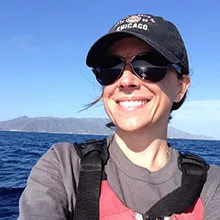Please review the information about our graduate programs at the bottom of this page. If you still have questions, send an email to gradadvisor@ceoas.oregonstate.edu or contact Lori Hartline, Graduate Program Assistant at 541-737-5188.
Our Ocean, Earth, and Atmospheric Sciences graduate degree program is built on internationally recognized faculty research programs within CEOAS, with Oregon State University currently ranked #3 in the world for Oceanography. The OEAS program pairs graduate students with faculty advisors in the student’s selected concentration area and encourages rapid engagement in research at the forefront of the respective field. The course curriculum for each concentration is designed primarily to provide the fundamental, specialized knowledge that enables scientific research in the corresponding field but also to give the student a broad perspective on the ocean, atmosphere, and climate systems and their interconnections. The close coordination of the five independent concentrations within the OEAS program offers unique opportunities for interdisciplinary research and education and provides a wide range of scientific and educational perspectives that enrich the graduate experience. Typically, the OEAS graduate program has over 50 active students, pursuing both M.S. and Ph.D. degrees. Brief overviews of each concentration are noted below, with additional details found in the student handbook linked below.
For applicants the most important step to take is to contact prospective advisors and discuss educational goals and research interests. In order to be accepted into the program, applicants must have an advisor who will agree to serve in this capacity. It is best if this contact happens prior to the application deadline, but it is not critical, and follow up contact with multiple potential advisors is extremely valuable. See Meet the Faculty section below.
Ocean, Earth, and Atmospheric Sciences Concentrations
The Ocean, Earth and Atmospheric Sciences graduate program at Oregon State University offers Master's and Ph.D. degrees with concentrations in Atmospheric Sciences. The program is currently seeking students with an undergraduate degree in physics, mathematics, engineering, chemistry, atmospheric science, or related fields with strength in mathematics. Applicants should have completed one year of physics with calculus, one year of chemistry, and courses in vector calculus and differential equations. Experience with programming and probability/statistics are also desirable. Most students accepted for study receive either Graduate Research Assistantships (GRA) or Graduate Teaching Assistantships (GTA) covering tuition and living expenses.
The graduate Atmospheric Sciences course curriculum includes the Ocean, Earth, and Atmospheric Sciences core courses, which provide a broad overview of the Earth system. All Atmospheric Sciences students take courses on atmospheric thermodynamics, radiation, and dynamics. Electives include courses on weather, climate, modeling, and air-sea interaction. Many students also take courses in physical oceanography, paleoclimate, remote sensing, or geophysical data analysis.
In geological oceanography (marine geology), a broad range of geological processes that influence the ocean is studied. Fields of interest include plate tectonics and the structure of the ocean basins, igneous petrology and geochemistry, paleoceanography and paleoclimatology, and coastal sedimentary processes.
Whether you want to do research in marine or continental regimes, whether you want to conduct experimental, applied, or theoretical geophysics, you’ll find opportunities for (literally!) ground-breaking graduate research here. CEOAS also offers a geology degree program; see this course plan sheet for differences between the OEAS Geophysics concentration and Geology degree.
The College of Earth, Ocean, and Atmospheric Sciences offers both Master’s and Ph.D. degrees in Ocean, Earth, and Atmospheric Sciences with a concentration on Ocean Ecology and Biogeochemistry. The course curriculum is closely integrated with the wide range of Earth science research conducted by OSU faculty. During the first year, students complete breadth courses in solid Earth, fluid Earth, and biogeochemical Earth, followed by two complementary upper-level courses: ocean ecological dynamics and ocean biogeochemical dynamics. During subsequent years, students can choose from courses on a wide range of topics including, benthic biogeochemistry, the marine carbon cycle, physical/biological interactions and coastal and estuarine oceanography. Technique-oriented courses are also offered on topics including experimental methods in physical oceanography, satellite remote sensing, data analysis, numerical modeling, and data assimilation.
The College of Earth, Ocean, and Atmospheric Sciences offers both Master’s and Ph.D. degrees in Ocean, Earth, and Atmospheric Sciences with a concentration on Physical Oceanography. During the first year, students take a course on descriptive physical oceanography and a comprehensive 3-quarter course sequence on geophysical fluid dynamics. First-year students may also take interdisciplinary courses in other oceanographic disciplines, as well as courses offered in the Mathematics Department at OSU. During subsequent years, students can choose from courses on a wide range of physical oceanography topics, including turbulence, geophysical waves, stability of geophysical fluid flows, and coastal and estuarine oceanography. Technique-oriented courses are also offered on topics including experimental methods in physical oceanography, satellite remote sensing, data analysis, numerical modeling, and data assimilation.
Explore the degree
For guidelines on how to apply, see Ocean, Earth, and Atmospheric Sciences Graduate Program Application Instructions.
Please see the current OEAS Graduate Student Handbook in the CEOAS Graduate Student Handbooks section of the Current Graduate Students page for information on course requirements, qualifying exams, and other information regarding degree requirements and resources.
Meet the faculty
Our Ocean, Earth, and Atmospheric Sciences faculty study every marine environment on Earth, from the nearshore to the deepest trenches. Learn more about our faculty who advise OEAS graduate students.
Interim Program Director
Jennifer Fehrenbacher

Learn about careers
At CEOAS, we are dedicated to helping you find a fulfilling job to set you on a successful career path. We have staff ready to help by connecting you to alumni mentors, helping you find internships, and investing in your professional development. As a result, most graduates are employed by six months post-degree.
Our ocean, earth, and atmospheric science students go on to shine in careers ranging from academia to government agencies to teaching and beyond.
Learn more about potential careers in oceanography, atmospheric science, and geophysics.